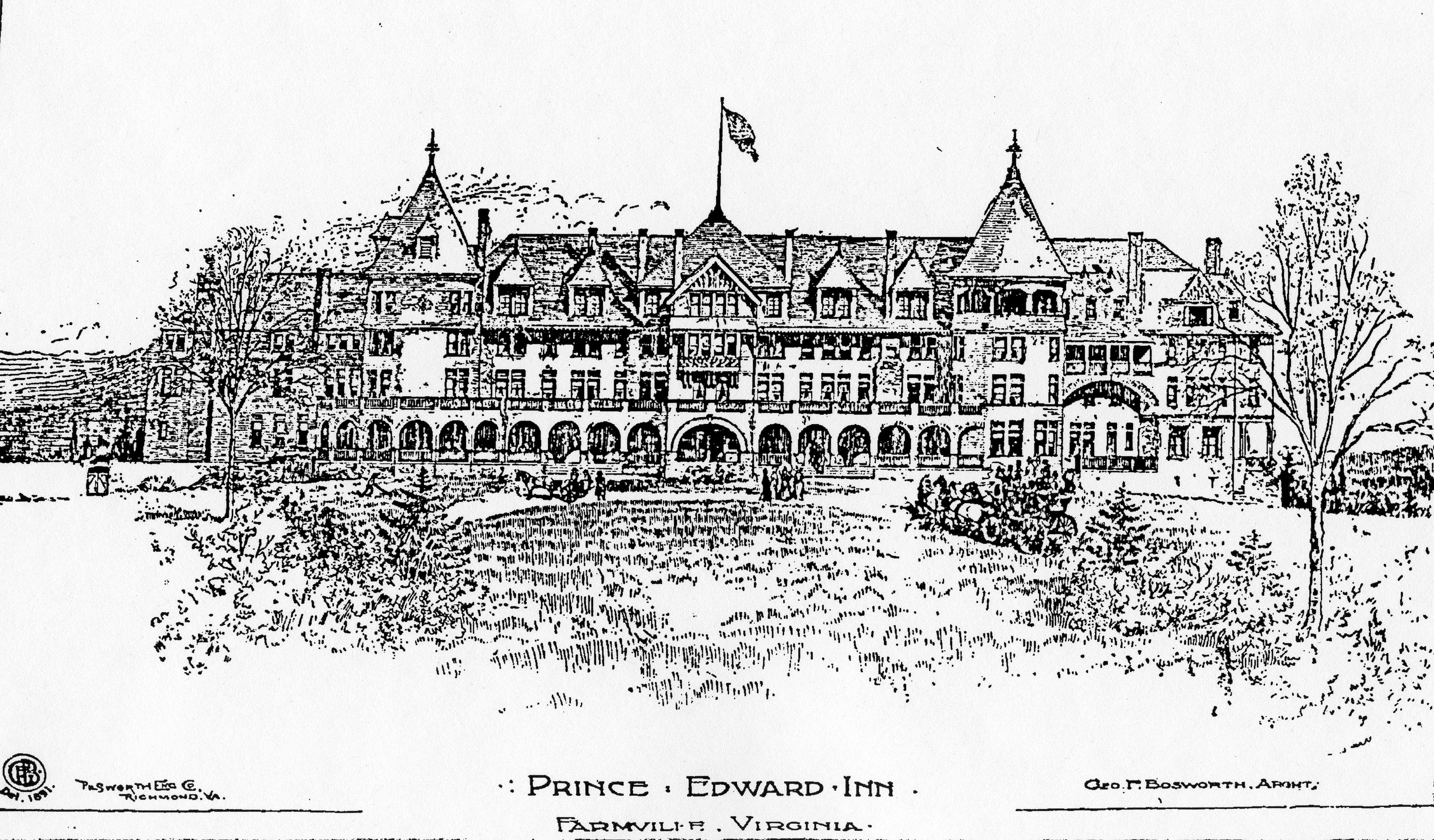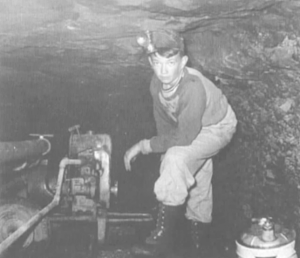The Farmville Coal & Iron Company
Published 11:50 am Wednesday, December 23, 2015

- An 1890 woodcut of what the Prince Edward Inn would have looked like, had the Farmville Coal & Iron Company (1890) built it “a few-hundred feet from the famous Houston Lithia Springs.” Lest you think they were just whistling Dixie, a hotel bigger than this was built by the Fort Payne Coal & Iron Company (1888) in 1889. John Houston (1822-1894) was manager of Lithia Springs. He is buried in Westview Cemetery.
Last in a series
Dr. Ray A. Gaskins
Professor Emeritus, HSC
From the beginning, the Farmville Coal & Iron Company made its plans based on three sources of revenue. “Its immediate source of revenue being the sale of lots and of coal. The Furnace Company, to be organized under the auspices of the Coal & Iron Company, will follow at the earliest practical moment, and will be its third source of revenue. Eight-hundred thousand dollars will be realized from the sale of lots, and after deducting liberal expenses and large dividends, a snug surplus remains to meet the demands of the Furnace Company and other kindred industries.”
Everyone was so sure the Furnace Company would be built in Farmville that the following notice appeared in the January 8, 1891, issue of “The Iron Age:” “John H. Mullin, mining engineer for the Fort Payne Coal & Iron Company, Fort Payne Ala., and superintendent of the Fort Payne Furnace Company, has accepted the position of general superintendent and mining engineer of the Farmville Coal & Iron Company, Farmville, Va. Mr. Mullin is still retained as consulting engineer by the Fort Payne Coal & Iron Company.” (Col. J.H. Mullin is named in the Jan. 20, 1891, company prospectus as “Civil and Mining Engineer in Charge.”)

(Photo courtesy Billy Poulston)
The Piedmont Coal Mine in Cumberland was pumped out and reopened in 1951 by George M. Stuart (1908-1984), with the help of his son, David M. “Jack” Stuart (1938-1995), shown here at age 12. After exploring the mine, which has an estimated 40-inch thick coal seam, it was again abandoned and soon re-flooded.
Exactly how much coal the company mined is unknown, but it was never more than 200 tons per day. In order to meet the projected “million tons a year” written about in 1890, they would have had to average 2,740 tons per day. How much iron ore they mined is immaterial because they never sold enough lots to finance the building of the furnace company. And now the Panic of 1893 would make it even more difficult to sell lots.
It was hoped that “The discovery and mining of coal near Farmville will quicken the construction of the Orange & Keysville (O&K) Railroad.” A charter was granted for the O&K RR in 1887 and in 1890 acquisition of property for its right of way between Farmville and Hampden Sydney began. Some railroad cuts in the vicinity of Hampden Sydney are still visible today, but no track was ever laid. (When the project was abandoned, the right of way was donated to Hampden-Sydney College.)
Anyone not yet aware that the Farmville Coal & Iron Company was in trouble became aware on Saturday, Jan. 27, 1894, when two notices of lawsuits being brought by Planters Bank for past due notes (one for $2,000 and another for $902.98) were published in The Herald. In addition, a notice of public sale was published on the same page, announcing that the coal pits in Cumberland would be resold at public auction on Monday, Feb. 19, on the courthouse steps. (This property, containing about 120 acres, was purchased from Mrs. Sallie W. Seay in 1891. The Seay Mines, located about four miles from Farmville, had a daily capacity of 200 tons of coal.)
By the summer of 1894, it became all too obvious that the Farmville Coal & Iron Company was failing. The town council made the best of a bad situation by purchasing key pieces of company property. For example, they purchased five acres, “lying north of and adjoining the cemetery,” for $800. This filled out what we now call Westview Cemetery so that it occupied all the land from Sanford Street to Gilliam Drive.
All good things come to an end, but it is truly ironic that the Farmville Coal & Iron Company expired about the same time as Gov. Philip McKinney’s term of office. Soon after ex-Gov. McKinney retired to Farmville, the company was gone, and so was the McKinney House, and was renamed the Old Dominion Hotel.
Looking back, there were those knowledgeable in the mining industry who predicted the failure. For example, an editor of “The Financial Mining Record” wrote on Jan. 24, 1891: “The Farmville Coal & Iron Company, with a capital stock of $1,000,000, is reported organized. I am unable to vouch for this enterprise. If coal or iron exists in this immediate vicinity in paying quantities, it is the first I have ever heard of [it].” The key phrase is “in paying quantities,” because the coal was — and is still — here.
The coal deposits centered around Farmville are collectively called the “Farmville Triassic Basin,” which stretches from Cumberland State Park to Briery Creek, with only a small portion straying into Buckingham. The Triassic is the first period of the Mesozoic Era, which began about 250 million years ago. The end of the Triassic period was the beginning of the Jurassic period, so there were no dinosaurs in Farmville when these coal deposits were laid down.
Coal was first mined in the Farmville Triassic Basin by John Flournoy in 1833. In 1837 he petitioned the General Assembly for a charter and one was granted on March 24, 1837, to “The Prince Edward Coal Mining Company” to mine and sell coal. This company was still in operation into the 1880s.
The coal vein worked by Flournoy was about 2 feet thick. Another coal pit in the 1880s was worked on the W.W. Jackson property. The coal from this small pit was used to fuel his blacksmith shop on the same property.
In 1860, John Dalby leased land from Nancy Allen and petitioned the state for a charter in the name of the Piedmont Coal Company. The mine was located just off of Plank Road, a mile and a half west of Raines Tavern. Piedmont Coal Company worked this mine during the Civil War, and the coal was used primarily for home heating. The mine was abandoned about 1866, when coal was bringing $2.50 per ton. The Farmville Coal & Iron Company reopened this mine in 1891. A spur line was constructed from the Tidewater & Western Railroad to the mine, and was used to transport the coal to Farmville and beyond. There were six workable seams on this property, with an aggregate thickness of 16 feet. Thus, the company had the coal and the means to transport it, but they failed anyway. (In 1869 John A. Dalby sold his 302 acre farm, located two miles west of Farmville, to Samuel H. Bliss and moved away.)
A small mine at Slate Hill, owned by John McCampbell Venable (1831-1899; CSA, H-SC 1853), was worked for one year by Dr. J.D. Eggleston, Sr. (1831-1908) and R.M. Dickinson (1840-1898) about 1880. Coal produced from this mine was used to heat homes. (Yes, this is the same Dickinson who became treasurer of the Farmville Coal & Iron Company and president of the bank that failed in 1893. It is a shame, too, because he had deep Prince Edward roots. He was born at “Springfield,” near Worsham, the son of Hon. Asa Dupuy Dickinson (1816-1884; H-SC 1836) and Frances Jane Michaux (1812-1844). Father and son, both lawyers, are buried at College Presbyterian Church Cemetery at Hampden Sydney. His mother is buried at the Michaux Family Cemetery at “Cork.”)
The coal is still there, ask any well driller. Slayton Well Drilling put down a well for Buckie Fore’s new home on the Back Hampden Sydney Road in 1991. Byron, son of Billy Slayton (1932-2012), remembers it well. It was the weekend of the Randolph Macon football game. They had just taken delivery of a brand new well drilling machine — a 458 Schramm — and this was the first time they used it. A Schramm representative was there to make sure there were no problems. They hit a vein of coal at about 100 feet. The vein was about 2 feet thick and when punctured, water and pieces of coal shot to the surface. Buckie says he can still detect coal dust in his water all these years later.
Byron says that hitting a layer of coal is common on the Back Hampden Sydney Road, especially between the 460 Bypass and town.
In the brief time that it existed, the Farmville Coal & Iron Company helped to shape the Farmville of today. For example, using The Herald it lobbied the town council for essential services, such as electricity and water. Thus, exclusive franchises for an electric power plant and a water works were awarded in 1890 and 1893, respectively.
Had the company hung on for only a couple of more years, its influence would have been more far-reaching and lasting (see woodcut of the Prince Edward Inn).





